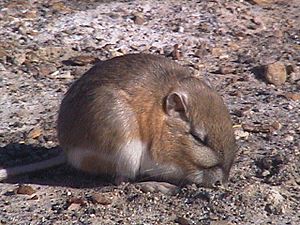Chisel-toothed kangaroo rat facts for kids
Quick facts for kids Chisel-toothed kangaroo rat |
|
|---|---|
 |
|
| Conservation status | |
| Scientific classification | |
| Genus: |
Dipodomys
|
| Species: |
microps
|
The chisel-toothed kangaroo rat (Dipodomys microps) is a small rodent that lives in the deserts of North America. It's famous for its unique front teeth, which look like tiny chisels! These special teeth help it eat salty plants, especially saltbush leaves. This amazing animal has learned how to get rid of the salt and still get enough water from its food. There are 13 different types, or subspecies, of this kangaroo rat.
About This Rat
Chisel-toothed kangaroo rats are small, quick animals. They grow to be about 27 centimeters (10.6 inches) long, including their tail. Their body is usually around 10 to 11.6 centimeters (4 to 4.5 inches) long. Their tail is even longer than their body, reaching up to 19 centimeters (7.5 inches)!
Their back fur can be sandy brown, gray-brown, or pale yellow. Their bellies are white, and their sides are yellow or yellowish-gray. They have a "tufted" tail, which means it has a little brush of dark brown hair at the end. The tail is brown with white stripes on the sides. They also have big, round ears that are two colors.
The most special thing about them is their front teeth, called incisors. These teeth are flat and wide, just like chisels. This unique shape is how they got their name and helps scientists identify them.
Where They Live
The chisel-toothed kangaroo rat lives only in the United States. You can find them in states like Nevada, Utah, California, Oregon, and parts of Arizona and Idaho.
They prefer dry, desert areas with gravelly soil. They usually live at medium heights, around 1,000 to 1,500 meters (about 3,300 to 4,900 feet) above sea level. However, some have been found much higher, up to 3,200 meters (10,500 feet)! Their favorite places are desert valleys and uplands where saltbush plants grow. They are not as common in sandy areas.
These kangaroo rats dig burrows in the ground, usually under bushes. Their burrows have several entrances, which helps them escape from predators.
What They Eat
The chisel-toothed kangaroo rat is a very special eater. It's the only type of kangaroo rat that mainly eats leaves! About 60% to 80% of its diet is made up of the leaves from a desert plant called Atriplex confertifolia. They do eat some seeds and insects, but not very much.
The Atriplex confertifolia plant has a clever way to survive in the desert. Its leaves are covered with a layer of salt crystals. This salt layer does two things:
- It reflects sunlight, which helps the plant stay cool and save water.
- It acts as a defense against animals that want to eat it.
But the chisel-toothed kangaroo rat has found ways to get around this salty defense! They have special body features, behaviors, and ways their bodies work to handle the salt. Their lower incisors (front teeth) have changed over time to become flat, wide, and chisel-shaped. This is a unique feature among all kangaroo rats.
Here's how they eat the salty leaves:
- They collect the leaves and stuff them into their cheek pouch.
- They carry the leaves back to their burrows. Sometimes they store up to 250 grams (about half a pound) of leaves!
- They use their unique chisel teeth to scrape off the salty outer layer of the leaf. They pull the leaf downwards against their lower incisors.
- They repeat this on the other side of the leaf.
- Once the salty outer layer is gone, they eat the inner part of the leaf. This part of the leaf can be up to 80% water in the spring. This is how the kangaroo rat gets most of its water!
- Another cool trick is that their upper lip can close off their mouth. This stops salt from getting into their mouth while they are scraping the leaves.


